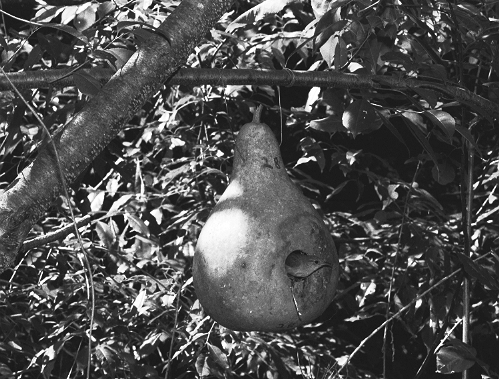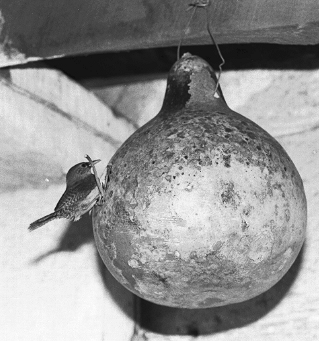| Richard & Diane Van Vleck - Personal Pages |
Wren Gourds

Whenever nestbox predation is discussed, raccoons and black rat snakes are usually identified as the primary culprits. However, in looking over the past ten years of our nestbox records, these two species don't even warrant mention. Our number two predator is the eastern chipmunk and, number one, by a landslide, is the house wren. Except in two years of extreme weather, wren predation caused more nest failures than all other causes combined, including weather and blowflies.
In addition to nest box usurpation, egg pecking and tossing, and infanticide, house wrens have frequently claimed all nest boxes placed in titmouse and chickadee habitat. One year, a great surplus of house wrens even took over 100% of our bluebird and tree swallow boxes, most of which were placed well away from any tall perch and far from wren habitat. The male wren will wait for an opportunity to enter the bluebird nestbox undetected, and peck or toss the eggs.
 While wrens have only had minor effect on bluebird nests in recent years, they have tied up all nest boxes placed for titmice, chickadees, flycatchers, and nuthatches. These boxes are located along a creek with mixed vegetation, from tall trees to dense thicket. Any boxes not used for nesting are filled with sticks, and refilled as soon as emptied.
While wrens have only had minor effect on bluebird nests in recent years, they have tied up all nest boxes placed for titmice, chickadees, flycatchers, and nuthatches. These boxes are located along a creek with mixed vegetation, from tall trees to dense thicket. Any boxes not used for nesting are filled with sticks, and refilled as soon as emptied.
Bluebirds and house wrens have frequently nested near each other in our yard, the bluebirds in a nest box and the wrens in a planter or trellis or some other nook or cranny. However, in the wilder creek area, all nest boxes have contained wren sticks or nests in recent years. Titmice may rear a first brood in one of the boxes, if lucky, but, the pressure from surrounding wrens is often overwhelming. We even have fewer Carolina wrens as the number of house wrens has increased.
Erecting more nest boxes at the creek area is futile, since the male house wren will frequently fill all potential nest sites with sticks. However, this year, quite by chance, I stumbled onto what might be, at least, a short term remedy for the wren problem. Last year's crop of martin gourd rejects (too small for martins) were prepared for wrens and placed among the five wooden nest boxes in a small section of the creek area. My purpose was a half-hearted attempt to saturate an area with nest sites, hoping that some might be ignored by wrens.
 I had never used small gourds for nest boxes before because the hole must be on an upward slope, allowing rain to enter, and, the thin walls would offer little insulation from the hot sun. Also, nest checks must be done with a dental mirror and nest changes are impossible. However, these gourds would be placed under heavy canopy where rain and sun would not be a problem.
I had never used small gourds for nest boxes before because the hole must be on an upward slope, allowing rain to enter, and, the thin walls would offer little insulation from the hot sun. Also, nest checks must be done with a dental mirror and nest changes are impossible. However, these gourds would be placed under heavy canopy where rain and sun would not be a problem.
All of the gourds were used by wrens, and all nests fledged 5-7 young each. Three of the gourds were used by house wrens, and the fourth by Carolina wrens. The nests remained dry and there were no nesting failures in the gourds. But, more importantly, only one of the five wooden boxes was used by wrens. And, this was a box that had been used by wrens for several years. Also, it was 122 feet from the nearest gourd. Perhaps its successful nesting record outweighed the appeal of the new found gourds. One week after nesting began in the wooden box, all four gourds were in use. When the second brood was begun in the wooden box, no gourds were available. The house wrens seemed so pleased with the gourds that they did not even bother to fill the other nearby wooden boxes with sticks. In one case, an empty wooden nestbox was only 15 feet from an active wren gourd. Only one other species (titmice) nested in one of the five wooden boxes. However, if the boxes are wren-free again next year, at least one more will likely be used. Before the house wren explosion, other cavity nesting species routinely used these boxes.
 Preliminary findings
Preliminary findings
- House wrens prefer gourds over wooden boxes.
- Wrens nesting in gourds ignored empty wooden nest boxes, even within 15 feet of their nesting gourd. In previous years, these surplus boxes would have been filled with sticks.
- All wren nests in gourds successfully fledged 5-7 young each.
Further questions
- Will other species attempt to nest in wren gourds? We used 1½" entrance holes for easier nest checking with a dental mirror and removal of sticks. However, a 1" hole should limit the gourd use to house wrens. Our goal is to make the wooden boxes available for titmice and other species by enticing the house wrens to switch to gourds.
- Can wren gourds be used in open areas where house wrens are destroying bluebird nests? All gourds this year were placed under tree canopy, thus protecting the unpainted gourd from sun and rain. While white paint is used on martin gourds, this may lessen the great appeal for gourds exhibited by wrens this year. While we are not seeking the perfect wren house, we don't want to cook or drown their young in order to free up housing for other species.
- Does putting out many gourds or nest boxes in wren habitat simply increase the number of wrens and thus, the problem? This year the total wren production was not significantly different from previous years. If boxes are to be provided for titmice, chickadees, flycatchers, and nuthatches, the result will likely also be a saturated housing supply for wrens. Adding gourds this year freed up all but one nestbox and did not increase the number of active wren nests in the study area.
As with all such preliminary tests, the wrens' interest in gourds may not be as strong in future years, and, they may return to the titmouse boxes. But, this year's data is encouraging.
Hopefully, others will have a supply of small gourds to test next spring. The average diameter of our wren gourds was 8 inches. A dental mirror small enough to pass through the entrance hole and a bright flashlight will allow inspection of the nest, but, observing wrens at the gourd for a few minutes is sufficient to determine the nesting stage. Watch for removal of fecal sacs and frequency of visits. When hanging the gourds, choose a location with a clear view from a nearby observation point. If this strong preference for gourds can be demonstrated at other sites and if it is repeated next year at this site, gourds may prove to be a useful tool in dealing with house wrens.
If house wrens are frequently usurping your nest boxes and you want to try gourds, the wooden nest boxes should first be moved so they won't be recognized as a previously successful nest site by the wrens. In selecting a new site for bluebird or tree swallow boxes, keep well away from shrubs, overgrown fence rows, etc. When house wrens first begin to take over old bluebird boxes, it is often because shrubs and trees have grown up near the nestbox. But, open areas aren't likely to attract the other cavity nesting species, so don't forget to put some boxes in your wilder areas. This is where wren pressure will be most severe and where the gourds should be tried. Record what species use the gourds and the nearby nest boxes and let us know what happens next summer.
Addendum The above was written in 1992. Since then, we have continued to offer wren gourds and have had very few problems with wrens using wood nestboxes anywhere on our property. Most of the small, unpainted gourds last up to four seasons. They are placed in sheltered areas with less direct sunlight and exposure to rain (hanging from lower branches of trees, under porch roofs and entranceways, etc.). A coat of paint would greatly lengthen the gourd's life, but I haven't wanted to do anything that might lessen the wren's amazing attraction to gourds. Growing wren gourds is not only easy, it is failure-proof, because wren gourds are simply the product of a failed attempt to grow purple martin gourds. If the product is too small for martins, its a wren gourd.
2015 update - Small gourds for house wrens were tested again in 2014 and a new plan is devised for 2015.
2014 house wren gourd project
Back to house wren page
American Artifacts home
email richard@americanartifacts.com
© 1992-2015, American Artifacts and Richard Van Vleck, Taneytown, Maryland.
 While wrens have only had minor effect on bluebird nests in recent years, they have tied up all nest boxes placed for titmice, chickadees, flycatchers, and nuthatches. These boxes are located along a creek with mixed vegetation, from tall trees to dense thicket. Any boxes not used for nesting are filled with sticks, and refilled as soon as emptied.
While wrens have only had minor effect on bluebird nests in recent years, they have tied up all nest boxes placed for titmice, chickadees, flycatchers, and nuthatches. These boxes are located along a creek with mixed vegetation, from tall trees to dense thicket. Any boxes not used for nesting are filled with sticks, and refilled as soon as emptied.

 I had never used small gourds for nest boxes before because the hole must be on an upward slope, allowing rain to enter, and, the thin walls would offer little insulation from the hot sun. Also, nest checks must be done with a dental mirror and nest changes are impossible. However, these gourds would be placed under heavy canopy where rain and sun would not be a problem.
I had never used small gourds for nest boxes before because the hole must be on an upward slope, allowing rain to enter, and, the thin walls would offer little insulation from the hot sun. Also, nest checks must be done with a dental mirror and nest changes are impossible. However, these gourds would be placed under heavy canopy where rain and sun would not be a problem.
 Preliminary findings
Preliminary findings